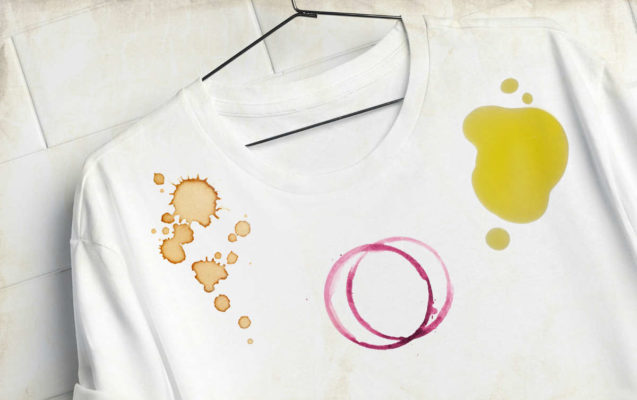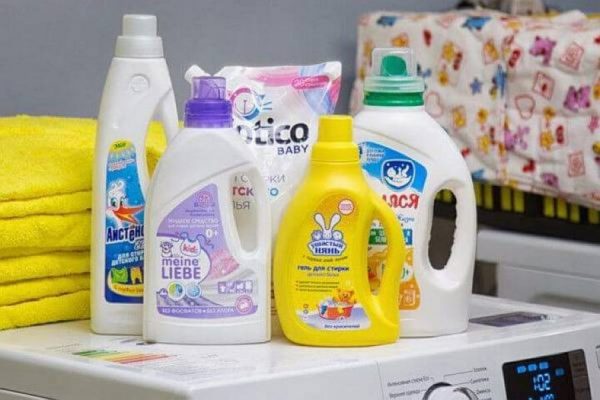Every person, even the most tidy, has encountered the problem of stains on clothes - coffee spilled on a favorite shirt, lipstick on a collar, grass marks after a picnic. Especially the clothes of small and curious “researchers of the world around us” - stains from fruit, juice, ice cream, grandma's pancakes, dirt collected throughout the yard.

Not You should despair and send your favorite thing to the dacha or to the trash heap. There are no contaminants that cannot be removed. Every housewife has quite a lot of tools for this in her arsenal: from stain remover to scissors (stains can be cut out) - this is, of course, a joke.
Ways to combat pollution
The problem of stains on clothes can be solved in several ways:
1. Trust the professionals and take the item to the dry cleaner. However, it is not too cheap, and there may not be an establishment of a similar profile nearby.

2. Use a ready-made product. On the shelves of hardware stores there is a huge selection of stain-fighting products - wipes, soaps, sprays and liquids. It is not a fact that these funds will help. And some stain removers themselves leave marks on the fabric, which then have to be removed.
3. Folk remedies proven over centuries – "grandmother's" advice. There are a lot of such recipes on the Internet.
What should be in your arsenal
What “ingredients” may be needed to remove contaminants:
- alcohol;
- salt;
- white vinegar;
- soda;
- washing powder;
- laundry soap;
- aspirin;
- hydrogen peroxide;
- ammonia;
- petrol;
- dishwashing detergent;
- glycerol;
- turpentine;
- acetone;
- starch or potato flour;
- citric acid or lemon;
- dentifrice.

Many of the listed components are available in the arsenal of every housewife or can be purchased for pennies.
What you will need

To remove stains of varying degrees of “severity,” “age,” and size, the following may be useful:
- pipette;
- cotton swabs;
- ear cleaning sticks;
- clean white rags;
- paper towels or napkins;
- sponge;
- old toothbrush;
- latex gloves.
What you need to know

When removing stains from things, you should follow certain rules so as not to harm the product:
- Before treatment, the stain must be thoroughly cleaned from dust with a brush.
- It is necessary to understand the nature of the pollution - grease, dirt, blood, grass, etc.
- When choosing a treatment product, you should take into account the characteristics of the fabric. Alcohol and acid destroy paint. Silk is not treated with acetone. Chlorine harms cotton fabrics. Bleach and alkali are used only on white items.
- On the wrong side, under the stain, place a board wrapped in several layers of white cloth or a paper towel so that the product does not spread and spoil the other side of the item.
- You should not start processing with strong agents. Sometimes it is enough to sprinkle a damp stain with salt, treat it with soap and wash it.
- If the stain is not removed the first time, it can be re-treated several times, alternating application of the product with thorough rinsing. In this case, you should carefully observe how the fabric behaves.
- Before use, any stain remover should be tested on the fabric by applying from the inside out to an inconspicuous place, such as a hem or seam.
- Treatment should be carried out from the edges to the center of the contamination. To ensure that there are no streaks left on the fabric, it is moistened around the stain with water or gasoline and/or sprinkled with talcum powder.
- The most common contaminants are from food and are of a fatty nature. They are removed with solvents - turpentine, acetone, gasoline or a mixture of these agents.
The listed solvents are volatile and flammable. Cleaning is carried out in a well-ventilated area. No fire is lit during operation. Products should be stored in bottles with tightly closed lids, out of the reach of children. Please remember that inhaling vapors may cause headaches.
Strong mixtures

If the moment is missed when a fresh stain could be cleaned with soapy water or another simple method, it is outdated and strongly ingrained into the fabric, they resort to more radical methods. Here are some of the most powerful recipes.
Remedy No. 1. Vigorous mixture for all stains on clothes - gasoline soap
This tool is universal. It is suitable for all types of fabrics, white and colored. Removes almost any stain.The downside of this recipe is that it is difficult to prepare, and you will have to look for the ingredients.

There are two methods of preparation.
Option #1
1. In half a glass (100 grams) of denatured alcohol, dissolve half a piece of baby or other white toilet soap, previously grated on a coarse grater.
2. Place the bowl with the soap-alcohol mixture in a pan of hot water and heat, stirring constantly. If the water has cooled, pour it out and add hot water.
Do not put the mixture on an open fire!
3. After the soap has completely dissolved in alcohol, pour a glass of aviation gasoline and 1 teaspoon of “OP-7” detergent into the slightly cooled solution. The mass is constantly stirred until it cools completely.
Some experienced “stain removers” advise replacing aviation fuel with gasoline for lighters.
Option No. 2
1. Mix oleic acid (12 parts by volume) with alcohol (4 parts).
2. Dissolve the resulting mixture in gasoline (180 parts).
3. Heat the mixture in hot water as in the previous recipe. DO NOT BOIL!
4. Continuously stirring with a wooden stick, gradually add a 25% ammonia solution (6 parts) to the resulting mixture. You should get a clear liquid.
The finished composition is stored in a dark glass container with a tight screw cap. It is used to treat any stains - from fat, blood, fruit and even from fuel oil, tar, resin, paint. Good for treating stains on work clothes.
Remedy No. 2, quite radical - oil solution
This recipe is simple and accessible. Helps remove long-standing stains, including those of unknown origin. Its advantage is that it can be used to clean children's things.

Cooking method:
- Bring 10 liters of water to a boil in an iron bucket or tank.
- Add half a glass (100 g) of washing powder, 2 tbsp. l. powdered bleach without chlorine and the same amount of any vegetable oil.
- Stir the liquid thoroughly, remove from heat and completely immerse dry clothes in the hot solution. Leave for 30 minutes, stirring the contents of the bucket occasionally.
- After the specified time, remove the items and rinse them thoroughly.
You will be surprised, but things will be clean. Stains from dirt, grass, fruit, and grease will be removed.
Remedy No. 3, very strong, using aspirin
This recipe will help in the fight against dried stains of fat, tomato, sauces and other contaminants. Very suitable for washing chefs' clothes, kitchen towels, tablecloths and napkins.

Cooking method:
- Grate laundry soap on a coarse grater.
- 1 tbsp. l. dilute soap in 1 liter of hot water.
- Add 2 aspirin tablets to the solution.
- Soak the laundry for 6-8 hours.
- Rinse thoroughly.
The resulting solution can be applied directly to the stain without treating the entire item.
Product No. 4 based on hydrogen peroxide

Cooking method:
- Mix equal proportions of hydrogen peroxide, baking soda and liquid dishwashing detergent until a paste-like mixture forms.
- Apply the resulting mixture to the stain using a toothbrush, lightly rub the stained area and leave for half an hour.
- Rinse off the product with water and wash the product.
To summarize, we can say with confidence: everything that has not been washed can be removed from clothing using accessible and inexpensive means. The main thing is to react quickly and not delay the stain removal process.
Let your family and friends always be neat, and let your favorite things last a long time!


 0
0





